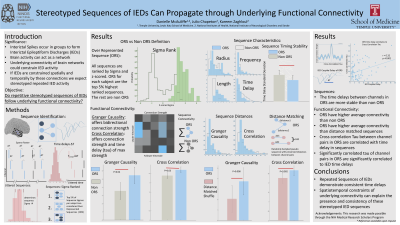Interictal Epileptiform Discharge Sequences Repeated During Seizures
Friday, April 21, 2023

Has Audio

Danielle McAuliffe (she/her/hers)
Medical Student
Temple University
Philadelphia, Pennsylvania, United States
ePoster Presenter(s)
Introduction: Epilepsy affects over 50 million people globally. Successful surgical management of epilepsy is dependent on identifying the seizure onset zone (SOZ) and spread. Interictal Epileptiform Discharges (IEDs) are captured within artifact free resting iEEG data, occur frequently, and are thought to mimic seizure initiation. 34% of surgical patients are not seizure-free, demonstrating the need for further understanding of epileptic networks to improve outcomes. Previous attempts using IEDs have been restricted to pairwise computations of electrodes. We hypothesize that sequences of IEDs can be identified, proxy epileptic networks, and mimic seizure progression.
Methods: 6 Participants underwent surgical placement of electrodes for intracranial monitoring at NIH. We identified IEDs by morphology and peak-trough amplitude and developed algorithms to capture sequences. Our custom sequence identifying algorithms offer advantages by allowing for unrestrained sequence length and were validated with synthetic data. We defined statistically over-represented sequences by comparisons against distributions of jittered data. We compared these sequences to both clinician and algorithm defined seizure metrics. The clinician provided SOZ channels. The page-Hinkley algorithm provided channel specific seizure detection times and Epileptogenicity Index (EI). We assessed overlap between IED sequence channels and clinician defined SOZ channels using a Jaccard index (JI) and compared sequence order to seizure detection times using a Matching Index (MI).
Results: Over-represented IED sequences exist in communities of multiple sequence lengths and can be detected in an unrestrained fashion. JI demonstrates significant overlap between clinically determined SOZ electrodes and baseline detected IED sequence channels (m=0.36 p=0.01). MI demonstrates significantly preserved order of IED sequences during seizure detection (m=0.22 p=0.03).
Conclusion : IEDs exist in reproducible, robust sequences that characterize communities. Moreover, these communities demonstrate both high overlap with the SOZ and order matching to seizure progression. This method of identifying IED communities is novel and can provide additional useful information for seizure mapping.
Methods: 6 Participants underwent surgical placement of electrodes for intracranial monitoring at NIH. We identified IEDs by morphology and peak-trough amplitude and developed algorithms to capture sequences. Our custom sequence identifying algorithms offer advantages by allowing for unrestrained sequence length and were validated with synthetic data. We defined statistically over-represented sequences by comparisons against distributions of jittered data. We compared these sequences to both clinician and algorithm defined seizure metrics. The clinician provided SOZ channels. The page-Hinkley algorithm provided channel specific seizure detection times and Epileptogenicity Index (EI). We assessed overlap between IED sequence channels and clinician defined SOZ channels using a Jaccard index (JI) and compared sequence order to seizure detection times using a Matching Index (MI).
Results: Over-represented IED sequences exist in communities of multiple sequence lengths and can be detected in an unrestrained fashion. JI demonstrates significant overlap between clinically determined SOZ electrodes and baseline detected IED sequence channels (m=0.36 p=0.01). MI demonstrates significantly preserved order of IED sequences during seizure detection (m=0.22 p=0.03).
Conclusion : IEDs exist in reproducible, robust sequences that characterize communities. Moreover, these communities demonstrate both high overlap with the SOZ and order matching to seizure progression. This method of identifying IED communities is novel and can provide additional useful information for seizure mapping.
